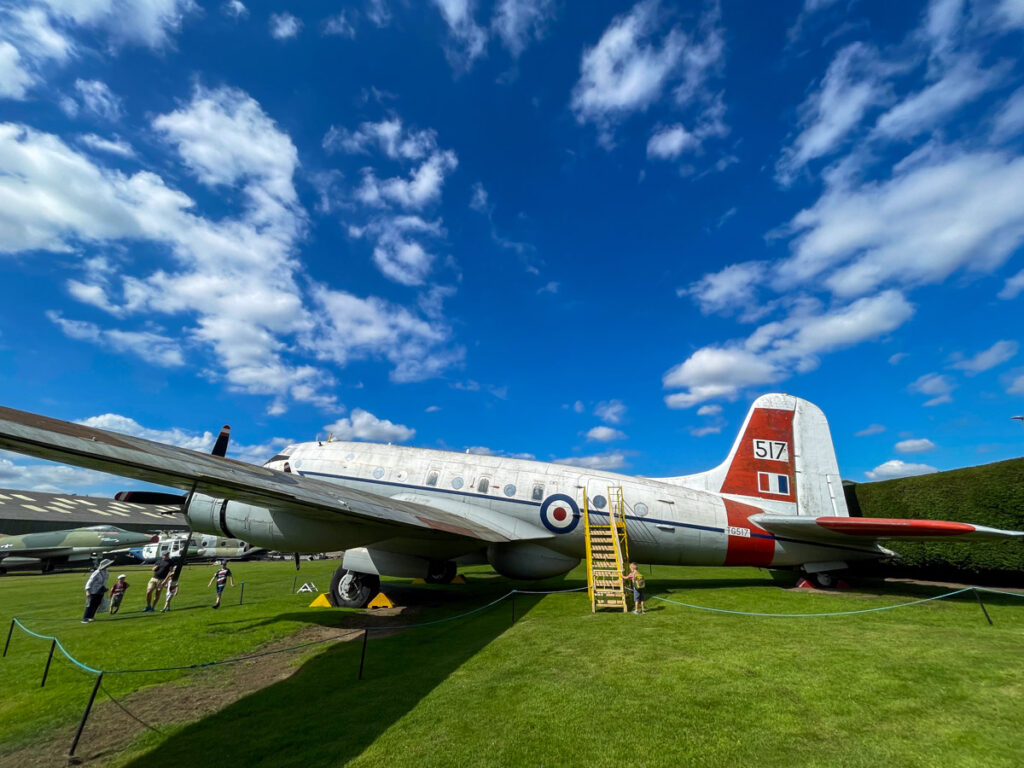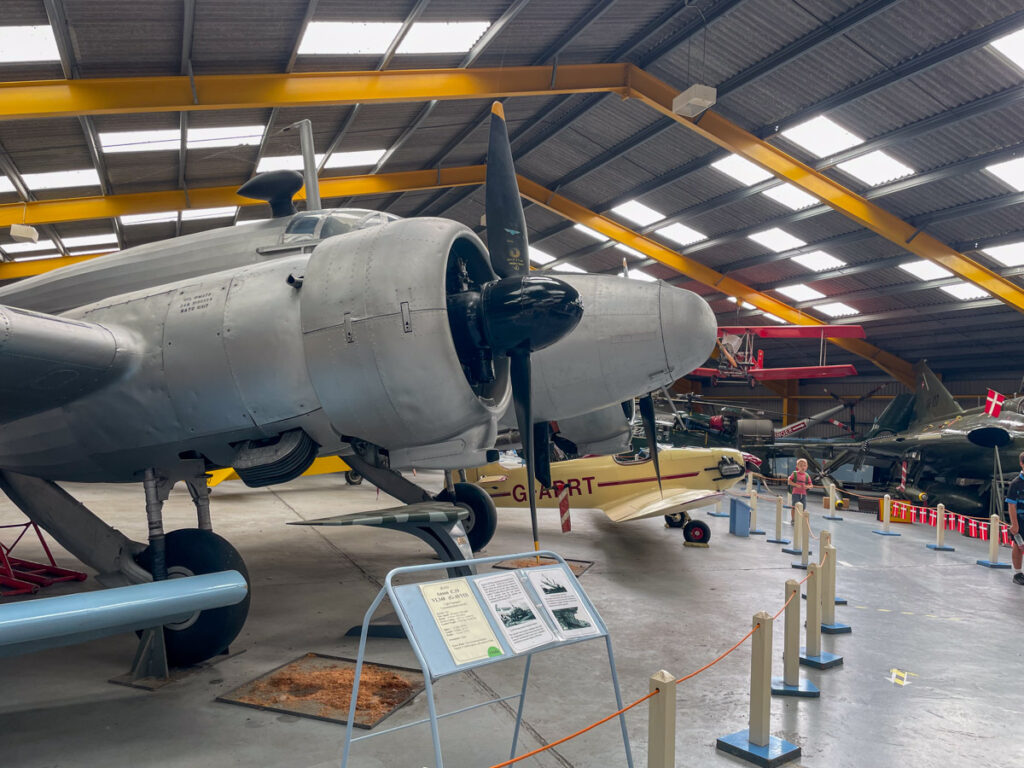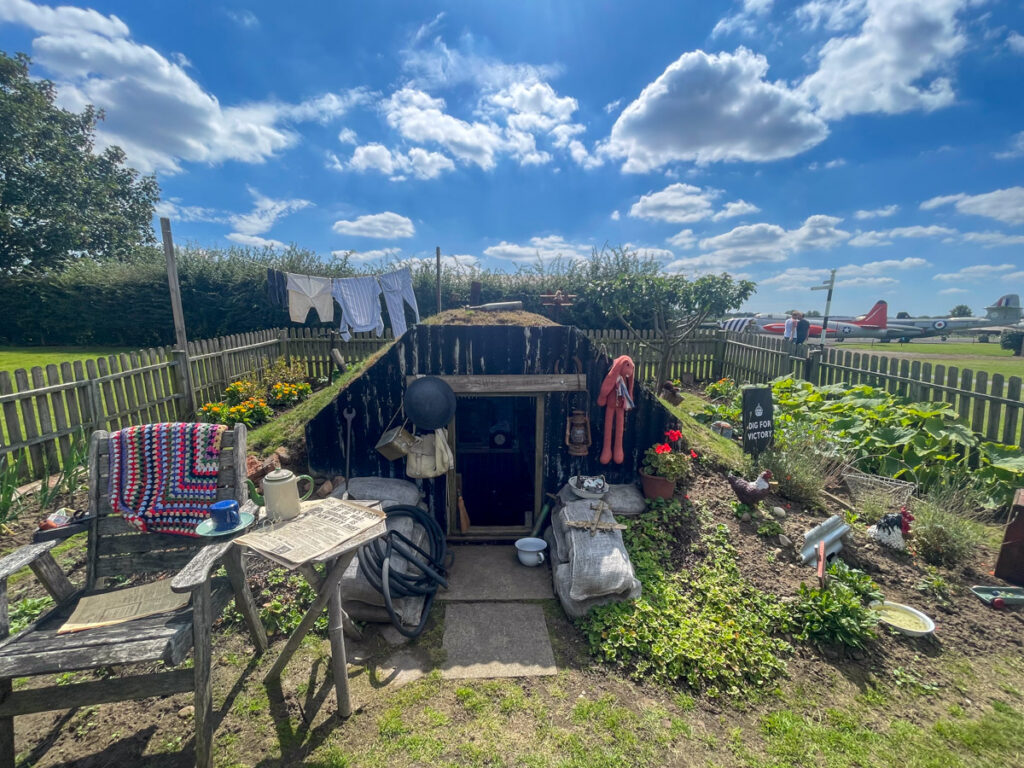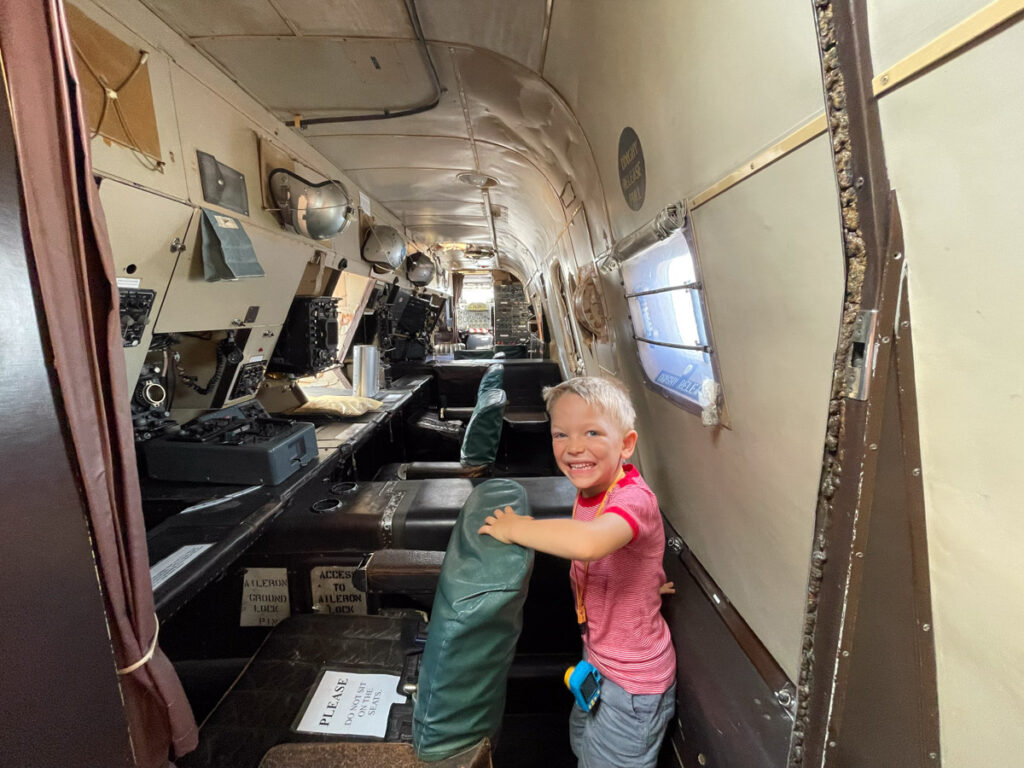Newark Air Museum is a well-known aviation museum in Newark, Nottinghamshire. The museum boasts a collection of over 96 aircraft and parts. Many of them are rare and unique and allows you to delve into the rich history of aviation in England. In addition, the museum is located on a part of the former RAF Winthorpe site. So you can also get a glimpse into the glorious Royal Air Force’s past. The airframes are restored to a high standard, with great attention to detail. You can even go inside a war and a training aircraft, as well as speak to friendly volunteers who have worked on these fantastic planes.
Table of Contents
What’s On at the Newark Air Museum
The Newark Air Museum is located on part of the former World War Two airfield of RAF Winthorpe and it is a true gem of the United Kingdom’s aviation history. With its 95 aircraft, extensive engine collection, and cockpit sections from across the history of aviation, it is the largest volunteer-managed aviation museum in the UK.
PLAN YOUR TRIP TO ENGLAND
Stay connected in England with a giffgaff free SIM or an Airalo eSim for seamless data coverage throughout the UK. Additionally, rent a car in the United Kingdom to explore all the attractions of the British countryside, including the fantastic museums on my blog!
As you wander through the museum’s two large display hangars, you’ll love the range of aircraft on display. The museum has something for every aviation enthusiast, from the quaint Tiger Moth biplane to the mighty Vulcan bomber. The museum’s outdoor area is equally impressive, showcasing even more unique aircraft. The museum’s dedication to aviation heritage is evident in every aircraft on display, with each piece meticulously cared for and presented.

Exhibits and Attractions at Newark Air Museum
The Newark Air Museum boasts one of the most interesting and captivating aviation collections in England. The museum’s assortment includes over 95 aircraft, ranging from military planes to commercial airliners. Some of the most notable aircraft on display at the museum include the Avro Vulcan, the Hawker Hunter, and the Vickers Viscount.
At the Newark Air Museum, you can explore the museum’s extensive collection of aviation artefacts, including photographs, uniforms, and engines. The museum has many British machines, combined with some truly unique exhibits from countries such as Denmark. There is no shortage of interesting aircraft to admire.
However, what made your visit memorable was not just the collection of aircraft but also the volunteers. They were all very happy to explain the aircraft’s history and their connection with it and answer any questions. The volunteers made our day and made a difference compared to other aviation museums we visited.
During our visit, many friendly veterans explained everything about flying before computers managed everything. We went inside a large aircraft used in a training role, and a volunteer – who worked there as a navigator when he was young – explained many things about flying and jobs in the Air Force. It was super interesting to listen to these things from real veterans!

Aircraft
The Newark Air Museum is home to a vast collection of impressive aircraft that tell the story of British aviation history. Outside and inside the museum, you can get up close with some of the most significant and awe-inspiring aircraft ever made. Among them are the Avro Vulcan, Avro Shackleton, Bensen gyrocopter, and de Havilland Sea Venom FAW.21.
The Avro Vulcan, a British delta wing bomber from the Cold War era, is a sight to behold. Its sleek design and impressive size make it a standout among the outdoor exhibits. Known for its role in the Falklands War, this aircraft is a symbol of British military might.
The Avro Shackleton, a maritime patrol aircraft used by the Royal Air Force, is another impressive aircraft. It served as a key player in the Cold War, and you can see it up close. Inside the museum, you can marvel at the Bensen gyrocopter, designed in the 1950s. This unique and quirky aircraft has an extremely minimalist design, with just the pilot’s seat, a rotor and a tailfin.
Another highlight of the indoor exhibits is the de Havilland Sea Venom FAW.21, a British carrier-based jet fighter with folding wings. You can admire its sleek design and imagine what flying such a powerful and agile aircraft must have been like. These are just some of the fantastic aircraft you can see at the Newark Air Museum. Each one tells a unique story and offers a glimpse into a different era of aviation history.

Hangar
Into the hangar, the Lancaster Corner is a unique collection of World War II artefacts, closely associated with the iconic Lancaster bomber and RAF Winthorpe, a vital training base for the 5 Group Bomber Command during the war. This corner houses several interesting artefacts that will fascinate any history buff.
The main part of the Lancaster Corner is the display dedicated to the 619 Squadron ME846 Lancaster aircraft and crew that tragically crashed over northern Belgium in June 1944. The extensive display provides a detailed account of the crew’s training on Stirlings with 1661 HCU at RAF Winthorpe, the events leading up to the fateful day when their Lancaster, ME846, was shot down, and the search to locate the crash site and the remains of the missing pilot.
Another notable item on display is the propeller blade from Lancaster AJ-S flown by Pilot Officer Lewis Burpee. This aircraft was shot down over Holland during the Dambusters Raid. You can also see a fuselage section of IX(B) Squadron Lancaster W4964 WS-J and the Lancaster rear turret, a crucial component of the Lancaster bomber.
Memorial Garden
The Newark Air Museum Memorial Garden is a peaceful place that commemorates the personnel who served with the 1661 HCU (Heavy Conversion Unit) at RAF Winthorpe. The garden is located in the Southfield Site of the museum and is home to a permanent memorial that honours those who lost their lives in a tragic aircraft crash on 1944 near Grantham during a training flight from RAF Winthorpe.
If you wish to visit the Memorial Garden, you can follow the path between the Shop round onto the Southfield Site. The route is clearly signposted and marked on the site plan. The garden is a fitting tribute to the courage and sacrifice of those who served their country and is a must-visit for anyone who wants to pay their respects and learn about the history of aviation.
Anderson Shelter
Outside the Newark Air Museum, you can see a fascinating display of an authentic Anderson Shelter from World War II. The shelter is set up with period-style bunk beds and fittings to add to its authenticity and give visitors a glimpse into what life was like during wartime. The shelter is fenced off and surrounded by a “Dig for Victory” vegetable plot named Victory Garden. Additionally, in the garden there is also a cute “Henderson Shelter” built for the hens.
For those who are not familiar, the Anderson Shelter was a popular type of air-raid shelter used during World War II in the United Kingdom. It is estimated that people built around 3.5 million Anderson shelters, which proved really effective. During air raids, Anderson shelters reportedly saved lives and prevented major injuries.
Designed in 1938 by engineer William Patterson, the Anderson shelter was named after Sir John Anderson, who was tasked with preparing Britain for German air raids. These shelters were provided free of charge to households with an annual income of less than £250, while others had to pay £7 for one.

Engines
The museum collection boasts an impressive array of over 40 aircraft engines, power units, and a rocket motor from the 1920s to modern times. These engines include some of aviation’s most iconic and powerful ones, such as the Olympus engine that propelled the Vulcan and Concorde to the skies.
These engineering marvels are on display in the dedicated Engine Building, right next to the Vulcan. Other engines are among the airframes on display in the museum’s hangars.
A Short History of Newark Air Museum
The history of the Newark Air Museum is as captivating as the aircraft it houses. Situated on the former RAF Winthorpe airfield, the Newark and Nottinghamshire Agricultural Society originally purchased the land. In 1968, a limited company was established, and the museum officially opened its doors in 1973. Since then, the museum has undergone significant expansion, including acquiring additional land to accommodate its impressive collection of aircraft and unveiling a second display hall in 2004.
What sets the Newark Air Museum apart is how the local community came together to protect the importance and memory of their history. Their tireless efforts have ensured the preservation of British aviation history. As you wander around the museum, it’s the volunteers, war veterans, and museum members who make this place truly special. Their dedication to expanding the collection with new exhibits ensures that the museum continues to grow year after year.

Practical Information to Visit Newark Air Museum
The Newark Air Museum showcases aviation’s rich history, including an impressive collection of vintage aeroplanes, helicopters, aero engines, and other aviation-related artefacts. It is a great place to visit with children, and it is also easy to reach by car.
You can enjoy a refreshing break at the museum’s cafe, which offers a range of delicious snacks and beverages. During our visit, we spent the whole day at the museum, andatee a good sandwich at the café, so I recommend it. If you prefer to eat your own food, there is also a lovely picnic area outside, perfect for sunny days.
You can also browse through the museum’s shop. It has a vast collection of models, aviation souvenirs, and books on aviation history.
Newark Air Museum with Kids
If your children are passionate about aeroplanes, I highly recommend taking them to the Newark Air Museum. During our visit, my son was over the moon to explore the many aeroplanes on display. He particularly enjoyed the opportunity to step inside some of them.
The volunteers were incredibly knowledgeable and passionate about aviation. They provided detailed explanations about the inner workings of the planes. We were surprise to know how aircraft functioned prior to the rise of automated technology. I was impressed with the museum volunteers’ ability to cater to all children. Overall, it was a fascinating and educational experience for my son and me.
Tickets and Opening Time
The museum is a wonderful place to visit, and it’s open almost every day of the year. It closes only on Christmas Eve, Christmas Day, Boxing Day, and New Year’s Day. From March to October, the museum is open from 10am to 5pm. During the winter months, from November to February, the opening hours change slightly, and the museum opens from 10am to 4pm.
The cost of admission to the Newark Air Museum is £11.00 for adults, while those over the age of 65 can purchase tickets for £10.00. Children’s tickets are available for £5.50, and families consisting of two adults and three children can purchase a family ticket for £30.00.
How to Get to Newark Air Museum
The Newark Air Museum is a fascinating destination for aviation enthusiasts and history buffs. It is situated on part of the former World War Two airfield of Winthorpe, in the eastern part of Nottinghamshire. The best way to reach the Newark Air Museum is by car from the A1, A46, A17, A1133 roads and the Newark bypass. Near the museum, you can follow the brown and white signs.
If you use Google Maps or a Sat Nav, enter the postcode NG24 2NY for directions. As you approach the museum, you will travel along a former wartime airfield taxiway, also shared with a neighbouring motor auction and storage business. Just pay attention to park in the right place, as it is easily to get confused. In fact, I initially parked in the auction and storage business park instead in the museum one. Outside the museum there is an ample free car parking.
Public transport
However, if you prefer public transport, it might be a bit more complicated. There is no direct public transport to the museum. If you choose to take the bus, the Lincoln bus service stops along Drove Lane, and from there, you will need to walk approximately half a mile to reach the museum. Alternatively, if you take the train, the museum is around 2.5 miles from the Newark Castle Station and approximately 1 3/4 miles from the Newark Northgate Station. In that case, you can take one of the local taxis available from the station to reach the museum.
Newark Air Museum
The Airfield, Drove Lane
Newark NG24 2NY
Newark Air Museum is an essential destination for aviation enthusiasts and anyone interested in the history of aviation in the UK. The museum’s extensive collection of aircraft and artifacts, but are the passionate volounteers that make the difference. Entering in a real training aircraft or in a cockpit with a veteran is an amazing experience. Whether you’re a seasoned aviation enthusiast or just starting to explore the world of aviation, Newark Air Museum is a must-visit destination. Feel free to share your experience in the comments!
